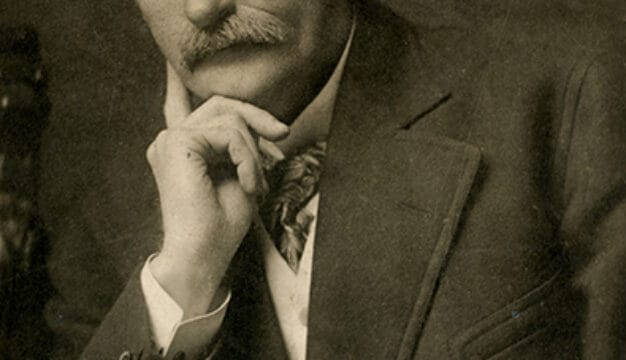Alabama Historical Association
The Alabama Historical Association (AHA) is an independent, nonprofit organization that promotes exploration and study of all aspects of Alabama‘s history. Supported financially through membership dues, the AHA welcomes everyone with an interest in Alabama history. Members come from a variety of fields and professions and reside in all regions of the state, as well as nationally. The AHA hosts an annual spring meeting and fall pilgrimage and sponsors the state’s historical marker program.
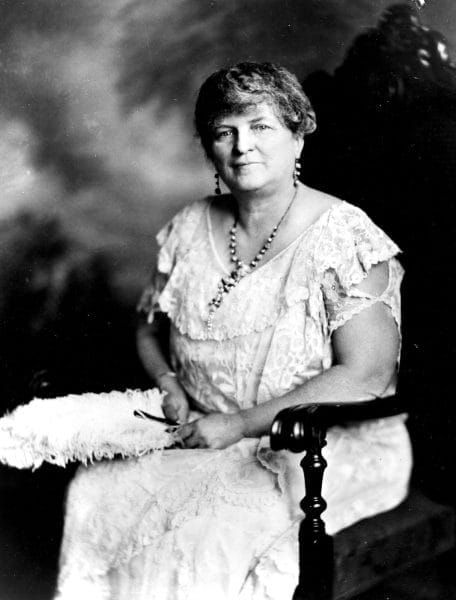 Marie Bankhead Owen
The AHA was founded in 1947 by a group of Birmingham businessmen with an interest in establishing an organization to explore and promote the state’s history. James F. Sulzby Jr., a real-estate executive from Birmingham, Jefferson County, was the earliest proponent of such an organization, and with the help of attorney William H. Brantley Jr., banker Rucker Agee, and corporate executive Richard J. Stockham, worked with Marie Bankhead Owen, then head of the Alabama Department of Archives and History (ADAH), to develop a list of potential members. Sulzby had a deep interest in Alabama history and was a collector of books, photographs, and other materials relating to the state.
Marie Bankhead Owen
The AHA was founded in 1947 by a group of Birmingham businessmen with an interest in establishing an organization to explore and promote the state’s history. James F. Sulzby Jr., a real-estate executive from Birmingham, Jefferson County, was the earliest proponent of such an organization, and with the help of attorney William H. Brantley Jr., banker Rucker Agee, and corporate executive Richard J. Stockham, worked with Marie Bankhead Owen, then head of the Alabama Department of Archives and History (ADAH), to develop a list of potential members. Sulzby had a deep interest in Alabama history and was a collector of books, photographs, and other materials relating to the state.
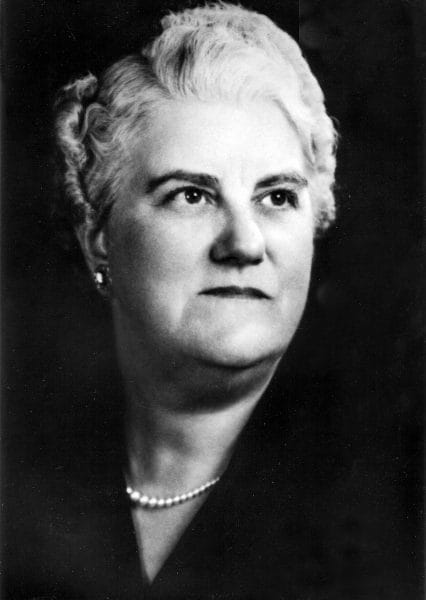 Maud McLure Kelly
Sulzby invited a list of 33 likely members and on April 19, 1947, held a meeting at Alabama College (now the University of Montevallo) to discuss the creation of a state historical association. After the group agreed to establish the AHA, Sulzby was elected president; Albert B. Moore, a history professor at the University of Alabama (UA), was elected vice-president; and ADAH official Maud McLure Kelly was named secretary-treasurer. The attendees voted unanimously to accept the draft constitution that had been submitted by Brantley. The new members also formed a committee to develop the concept for a state historical journal and established a schedule for a formal annual meeting. In June 1947, AHA published its first monthly bulletin.
Maud McLure Kelly
Sulzby invited a list of 33 likely members and on April 19, 1947, held a meeting at Alabama College (now the University of Montevallo) to discuss the creation of a state historical association. After the group agreed to establish the AHA, Sulzby was elected president; Albert B. Moore, a history professor at the University of Alabama (UA), was elected vice-president; and ADAH official Maud McLure Kelly was named secretary-treasurer. The attendees voted unanimously to accept the draft constitution that had been submitted by Brantley. The new members also formed a committee to develop the concept for a state historical journal and established a schedule for a formal annual meeting. In June 1947, AHA published its first monthly bulletin.
From its outset, AHA was a cooperative effort of professional and amateur historians that welcomed membership from the general public. Sulzby’s enthusiastic promotion of the organization soon brought members from across the state, including powerful corporate and political leaders. He also worked with history departments and administrations at the state’s universities and colleges to create networks with professional academics. For example, Alabama Polytechnic Institute (now Auburn University) president Ralph Brown Draughon served as AHA president from 1952 to 1953, and he was succeeded by Birmingham-Southern College president George R. Stuart.
By November 1947, Sulzby had established a formal relationship with the UA to house and publish the state’s new history journal. UA librarian and history enthusiast W. Stanley Hoole was installed as the first editor, and James B. McMillan, director of the University of Alabama Press, was named managing editor. The periodical was officially named The Alabama Review: A Quarterly Journal of Alabama History. The University of Alabama Press continued to produce the Alabama Review until 1996, when its editorial offices moved to Auburn University’s history department. In 2012, the journal’s publication responsibilities were handed over to the University of West Alabama, and in 2017 it moved to the University of Mobile.
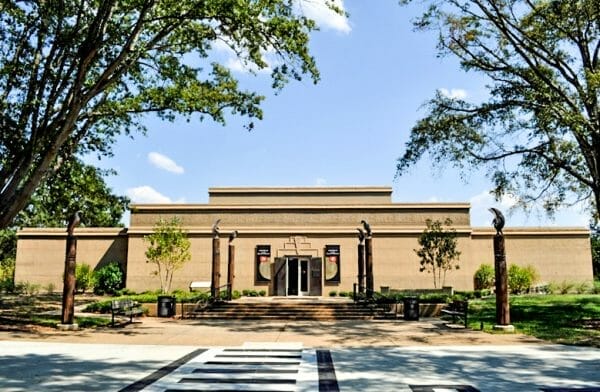 Jones Archaeological Museum
The AHA’s first annual meeting, held in Montgomery on April 17, 1948, featured four papers and a dinner and was attended by more than 250 people. Attendees also toured the First White House of the Confederacy and were treated to a reception at ADAH, which had mounted a special exhibit of documents relating to Alabama’s territorial period and early statehood. The following year, Mobile native Willie Mae Wefel became the first woman to serve on the board. In 1949, under the leadership of Rucker Agee, AHA created the state’s first program to install historical markers at important sites throughout the state. The organization established a committee to determine a list of markers and to help local communities develop text for them. The committee also raised funds from private donors to produce and install the markers. The first marker was placed that year at the University of Alabama. In 1956, AHA worked with Alabama Public Television to produce a series called Alabama Heritage, which aired between September and December. The individual programs focused on places of importance in Alabama’s history, including Moundville and the Shelby Iron Works, and featured historians and archaeologists as well as materials from ADAH.
Jones Archaeological Museum
The AHA’s first annual meeting, held in Montgomery on April 17, 1948, featured four papers and a dinner and was attended by more than 250 people. Attendees also toured the First White House of the Confederacy and were treated to a reception at ADAH, which had mounted a special exhibit of documents relating to Alabama’s territorial period and early statehood. The following year, Mobile native Willie Mae Wefel became the first woman to serve on the board. In 1949, under the leadership of Rucker Agee, AHA created the state’s first program to install historical markers at important sites throughout the state. The organization established a committee to determine a list of markers and to help local communities develop text for them. The committee also raised funds from private donors to produce and install the markers. The first marker was placed that year at the University of Alabama. In 1956, AHA worked with Alabama Public Television to produce a series called Alabama Heritage, which aired between September and December. The individual programs focused on places of importance in Alabama’s history, including Moundville and the Shelby Iron Works, and featured historians and archaeologists as well as materials from ADAH.
 Alabama Historical Association Officers, 1959
In 1958, with the encouragement of Brantley, local Pike County historian Margaret Pace Farmer became the first woman to serve as president of the AHA, over the initial opposition of several board members. That same year, AHA initiated its fall pilgrimage, an annual trip to sites of historical interest in the state. The first tour took place in Cahawba, the state’s first capitol, and the second in the town of Claiborne, Monroe County. Pilgrimages typically feature tours of historic homes and other sites in the host city or town.
Alabama Historical Association Officers, 1959
In 1958, with the encouragement of Brantley, local Pike County historian Margaret Pace Farmer became the first woman to serve as president of the AHA, over the initial opposition of several board members. That same year, AHA initiated its fall pilgrimage, an annual trip to sites of historical interest in the state. The first tour took place in Cahawba, the state’s first capitol, and the second in the town of Claiborne, Monroe County. Pilgrimages typically feature tours of historic homes and other sites in the host city or town.
Although the AHA was open to nonprofessionals, membership remained exclusively white until Auburn University history professor Allen Jones began pushing the organization to admit black scholars. In 1972, Jones recommended Auburn history professor Robert D. Reid for membership. At first, the executive board rejected him, and Jones responded by threatening a lawsuit against the organization. Fearing negative publicity, the board reconsidered its decision and awarded membership to Reid in 1973, making him AHA’s first African American member. Although the incident was settled without public scrutiny, it created resentment among some of the members about the level of control over the organization exercised by Sulzby and the other administrators. AHA membership peaked in the 1970s and then declined, largely and ironically as a result of its efforts to create local historical societies throughout the state. In the 1980s, University of Montevallo history professor Justin Fuller became membership secretary and did much to modernize and streamline the membership process, computerizing many of the records. In 2019, former ADAH head of reference Frazine Taylor became the first African American president of AHA.
The AHA has supported a number of efforts to preserve Alabama’s history in the state, including the creation of Horseshoe Bend National Military Park in Tallapoosa County, an initiative led by AHA president Clinton Jackson Coley, and Alabama Constitution Hall Historic Park and Museum in Huntsville, Madison County. AHA also assisted in the effort to bring the USS Alabama to Mobile and create a park honoring its service during World War II.
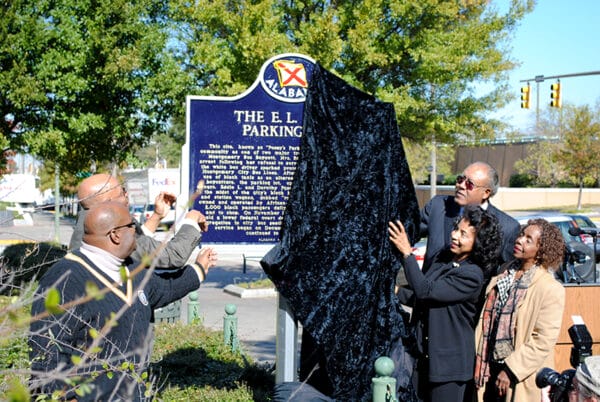 Posey Parking Lot Marker Unveiling
AHA is governed by a volunteer board of directors as well as a president, vice president, secretary, membership secretary, and treasurer. Board members serve three-year terms, and the organization also has 13 committees that oversee various aspects of AHA’s activities, including the Publications Committee and the Executive Committee. The AHA continues to sponsor the Alabama Review and the state’s historical marker program. The spring annual meeting features tours of historical sites, presentations of scholarly papers, a banquet, and a keynote speech, and the fall pilgrimage offers members tours of historically significant communities and sites in the state. The AHA also presents a number of awards each year, including the Sulzby Award, which recognizes a book that has made a significant contribution to Alabama history, and the Clinton Jackson and Evelyn Coley Research Grant for graduate study.
Posey Parking Lot Marker Unveiling
AHA is governed by a volunteer board of directors as well as a president, vice president, secretary, membership secretary, and treasurer. Board members serve three-year terms, and the organization also has 13 committees that oversee various aspects of AHA’s activities, including the Publications Committee and the Executive Committee. The AHA continues to sponsor the Alabama Review and the state’s historical marker program. The spring annual meeting features tours of historical sites, presentations of scholarly papers, a banquet, and a keynote speech, and the fall pilgrimage offers members tours of historically significant communities and sites in the state. The AHA also presents a number of awards each year, including the Sulzby Award, which recognizes a book that has made a significant contribution to Alabama history, and the Clinton Jackson and Evelyn Coley Research Grant for graduate study.

